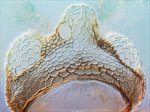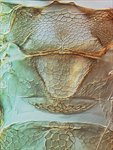
javanicus fore wing

javanicus head

javanicus antenna

javanicus meso & metanotum

javanicus tergites VIII-IX
Generic diagnosis
Female macropterous. Body blackish-brown and broadly robust; fore wings with two black swellings on fore margin. Head reticulate, with long ocellar hump overlaying first ocellus; maxillary palps small, 2-segmented. Antennae with 8(7) segments, VI–VIII forming a tapering unit; III and IV each with a forked sense cone that lacks a basal stem, IV with an additional simple sense cone. Pronotum strongly transverse, without long setae. Mesonotum without anterior campaniform sensilla; median setae in front of posterior margin. Metanotum broadly triangular, reticulate, without campaniform sensilla, median setal pair on posterior third. Fore wing broad, with 2 or 3 prominent blisters, without promient veins or setae but terminal seta elongate; surface microtrichia near base almost tuberculate. Prosternum without discal setae, prosternal spinasternum slender. Mesosternum without spinula. Metasternal furca V-shaped, extending to mesothorax. Mid and hind tarsi 1-segmented. Tergite median setal pair long and close together in a median reticulated groove; tergites with toothed craspedum on lateral thirds, VIII posterior margin with complete comb of long microtrichia; IX without anterior campaniform sensilla; X without longitudinal split. Sternites III–VII each with 3 pairs of small setae arising submarginally, VII with 2 pairs of supernumerary setae.
Male similar to female; tergite IX without stout setae; sternites III–VII each with transversely oval pore plate on antecostal ridge.
Biological data
These are leaf-feeding thrips, and are commonly found on plants with relatively hard leaves, and not on the softer apical leaves. Various cultivated plants are attacked, including Diospyros, Ricinus, Rosa, and Vitis.
Distribution data
Both species in this genus are from Southeast Asia, but syriacus is widespread in tropical countries, including South America. In contrast, javanicus is recorded only from Indonesia and Northern Australia. One or both of these can be expected to occur in Southern China.
Nomenclatural data
Retithrips Marchal, 1910: 17. Type species Retithrips aegyptiacus Marchal, 1910, by monotypy, synonym of Thrips (Heliothrips) syriacus Mayet, 1890.
This genus comprises two species, both from Southeast Asia (ThripsWiki, 2020), but neither of them has yet been recorded from China.
Relationship data
Thripidae sub-family Panchaetothripinae: this group is represented widely around the world, particularly in tropical areas, and comprises about 40 genera. The two species of Retithrips are remarkable for the two (or three) dark blisters on the fore wings, and the ocellar region of the head that is produced over the base of the antennae.
References
Mound LA, Tree DC & Paris D (2012) OzThrips – Thysanoptera in Australia. http://www.ozthrips.org/
ThripsWiki (2020) ThripsWiki - providing information on the World's thrips. <http://thrips.info/wiki/Main_Page>
Wilson TH (1975) A monograph of the subfamily Panchaetothripinae (Thysanoptera: Thripidae). Memoirs of the American Entomological Institute 23: 1–354.